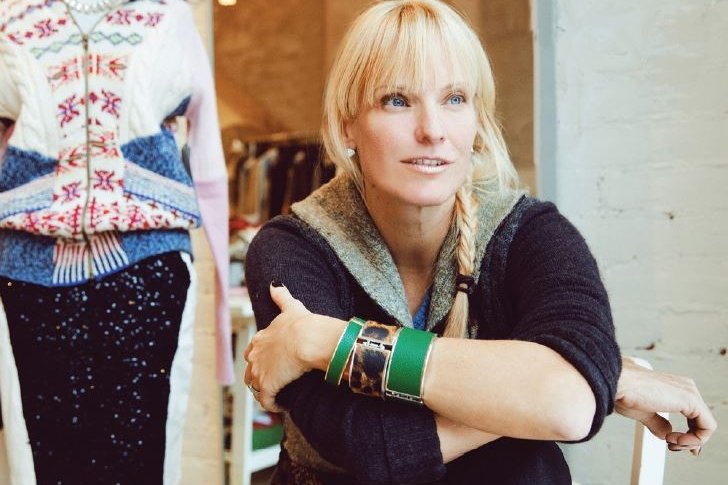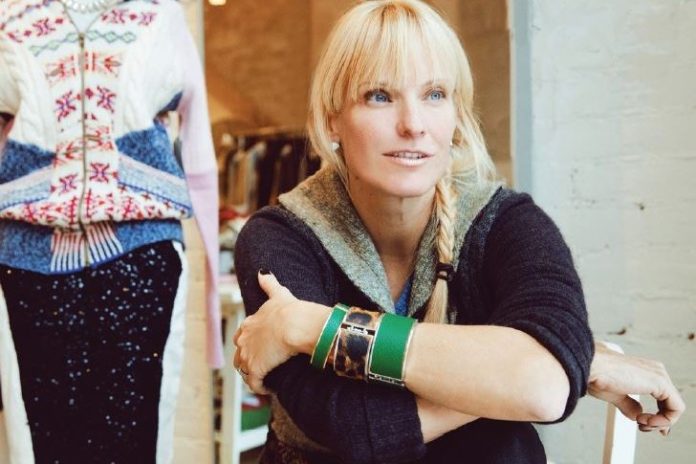
Julia Grieve became an “accidental environmentalist” nearly 25 years ago when she started the Canadian eco-fashion brand Preloved. Discover what makes Preloved sustainable, what Grieve has learned throughout her journey, and what true success means to her.
Long before slow fashion became a #movement, Julia Grieve identified an opportunity to recycle vintage clothing into one-of-a-kind pieces for the modern woman. In 1995, Grieve—a self-proclaimed ”accidental environmentalist“—launched Canadian eco-fashion brand Preloved. ”When I started Preloved,“ says Grieve, ”honestly, we were just about making cool and unique and cutting-edge clothing.“
Since the brand’s conception, Preloved has kept more than 1 million sweaters from entering the landfill, positioning the company as a leader in the eco-fashion industry—something Grieve calls “the most wonderful byproduct that you could ever imagine.”
When old becomes new again
In an ideal world, the clothes we drop off at our local thrift store are sold to new owners who treasure our trash; however, according to recent news outlets, only 25 percent of donated clothing actually ends up on store floors, much of which doesn’t even sell. The remainder is typically shipped abroad, cut down into rags, ground down and reprocessed, or sent to the landfill.
It’s at this stage that Grieve and her team source the materials to be transformed into new items entirely—like their hats, mitts, and scarves. They’re also often blended with deadstock and overrun fabric—leftover fabric from textile mills and garment factories that cannot or will not be sold—like their tops and sweaters.
Whereas a traditional fashion designer will imagine a look and source the appropriate materials, Grieve works backwards, taking stock of the materials she has access to and figuring out creative ways to use it. “It really ebbs and flows depending on the season,” says Grieve. “If we come across a gorgeous lace and we’ve been dying to work with it then boom, let’s run lots of those!”
Canadian roots
In addition to using materials destined for the landfill, Preloved gets its sustainable stamp of approval from being 100 percent locally made in Canada. According to Grieve, they’ve “made huge decisions to keep this brand local—so much so that we moved right into our factory.”
They even partnered with Canadian brand Roots to develop a collection, blending Roots’ signature fabrics with more than 6,000 vintage sweaters. Grieve loves partnering with other brands because it creates a great quality product: “We’re using 100 percent cotton, fleece, terry, but then we’re blending in a heart out of old sweaters, so the line has consistency.”
Preloved gets its sustainable stamp of approval from being 100 percent locally made in Canada.
Slow fashion, fast-paced world
A Canadian fairy tale indeed, but running this eco-fashion line hasn’t been without its challenges. For years, Preloved had brick and mortar stores across Canada, with plans to open another in Vancouver; however, an illuminating meeting with Canadian fashion designer Joe Mimran prompted Grieve to buy out of a 10-year lease and abandon Vancouver entirely.
Mimran told Grieve, “There’s just no possible way mathematically that store is ever going to make any money, and if you are not careful, it will pull down your whole ship.”
According to Grieve, this was one of the most stressful times in her life, and it forced her to look inward. She says that, as an entrepreneur, there’s an “amazing excitement and amazing determination and amazing ego that got you to start [your], but it can kill you if you’re not careful.”
Having it all?
In addition to running a thriving fashion company, Grieve is also the proud mother of three children. When she’s not working, she’s hosting her parents for dinner twice a week, driving her children to their respective activities, or squeezing in 20-minute coffee dates with her husband.
And although she leads a very full life, when she hears about women “having it all” she can’t help but object. “I think that the message is just a little bit backwards,” says Grieve, “What I think it should be is, ‘You have all the choices.’”
Grieve has chosen a family while running an international eco-fashion business. At times she’s missed meetings when choosing to focus on her children; other times she’s missed bake sales. She chooses to wake up at 4:30 every morning to make sure she gets her daily workout in.
And while she is grateful for the myriad choices she does have—choices that “were not available even 20 years ago, definitely not 40 years ago”—she feels it’s important for the message to change, so that women aren’t set up for failure.
When asked what the true measure of success is, Grieve says it’s happiness: “I just find the days go by so fast, the years go by so fast, and you spend all this time trying to look successful, feel successful, see it in your bank account … and I just want to wake up and I want to feel happy.”
Your eco-friendly wardrobe
Before you purchase a new item of clothing, keep in mind these quick tips for building an
eco-friendly wardrobe.
- Ask yourself, do you need it?
- If you do need it, can you thrift it? Can you find it vintage?
- If you must buy it new, choose brands that are transparent about their manufacturing and labour practices.
- Avoid synthetic fibres such as polyester, nylon, acrylic, or rayon, which release microplastics when washed, making their way into our oceans and threatening marine life.
- Choose natural fibres such as organic cotton, bamboo, linen, or hemp.
- Choose timeless cuts and colours made to last.
- Sew your own clothes!
Tonnes of waste
In 2016, Canada sold more than $160 million of unwanted clothing to overseas buyers around the world. That which isn’t sold contributes to the 12 million tonnes of textile waste that makes its way to North American landfills every year.
The Mend Trend
Part punk, part ancestral skills education, the visible mending movement is picking up speed. Using an easy-to-learn running stitch, interesting fabric patches, and colourful thread, you can mend and patch worn clothing to add character and build an intimacy between you and your clothes.
Preloved has kept 1 million sweaters from entering the landfill, positioning the company as a leader in the eco-fashion industry.”
























